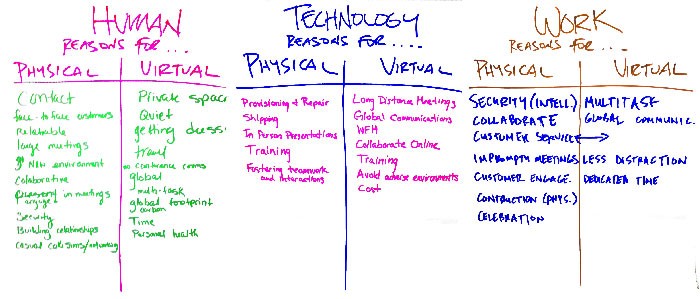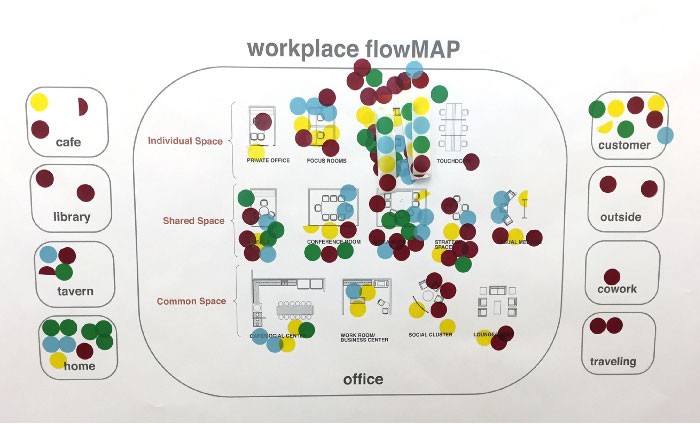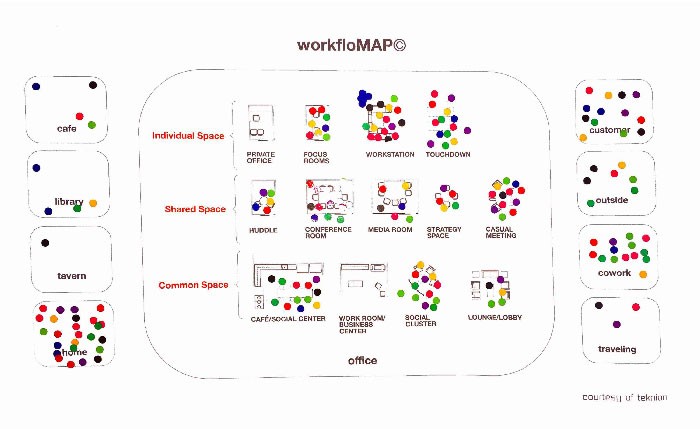DESIGNER Q&A: Greg Dekker, Teknion
Whilst Gregg Dekker visited the UK to speak at Corenet Global we took the great opportunity to ask him more about workfloMAP©
1. Please tell me a little about yourself?
I am VP Sales and Strategy Effectiveness, for the Teknion Corporation, managing its training and development programs and a leader on customer collaboration. I am an active facilitator who speaks, advises, and creates immersive experiences on change planning, understanding generational differences, and workplace effectiveness, and has served many of the most dynamic corporations around the globe.
I am the author of seminars for discovery – including the FOCUS Game, The Jetsons, and Power Tools for Change. He leads PODIUM©, a program for advanced customer collaboration. My use of tools and engaging style hopefully makes learning memorable and effective.
1. In a future with technology that allows nearly everyone to work from anywhere, do you think people will still travel into offices to work?
This is the central question of a workshop I wrote called, The JETSONS, and have since given this workshop with nearly 100 conference audiences or customer focus groups over the past 18 months. In the course of this work, we’ve kept track of the data and would answer that question as a highly nuanced “YES.”
The book and movie The Martian make some important illustrations about the future of work. (Spoiler alert: in the first five seconds Matt Damon is left behind on Mars.) The remaining entirety of the story is about three questions: what WORK ACTIVITIES need to be done; what TECHNOLOGY TOOLS do they have or don’t have; and what are the HUMAN FACTORS for the people on Earth, on MARS, or in between?
In our workshop, participants work together to brainstorm all the elements of these three categories, then to determine for themselves how each category will likely demand that people work physically-together, or virtually – apart.
The three photos above show you what the results typically looks like, as teams of 2-10 people record their thoughts and debate the three categories of Human Factors, Technology Tools, and Work Activities. Some groups were as small as 10 people, other groups were audiences of 200. But the results were similar among them, as we asked the breakout teams to come up with one number on a scale of 1-10 that best represents their prediction for the category they debated, where a “1” represents a completely Physical workplace, a “10” represents a completely Virtual workplace. A “5” would be somewhere in the middle, and so on.
The results?
Business Activities – has been averaging a “5.” So, the groups tend to find that about 1/2 our work can be done from anywhere, and another 1/2 is best done together.
Technology Tools – it’s been averaging a “7.” Clearly, participants believe that the tools we have now and will have in the future will make it possible to work from virtually anywhere. Interestingly, when I began this work in the San Francisco Bay Area and Silicon Valley. There, groups frequently rated this category as 8, 9 or even 10. But just about anywhere else, people were far more skeptical about Technology, more commonly rating it lower, as a 6 or 7.
Human Factors – has been averaging a “3”. Clearly participants believe that people find value or even necessity in being together.
To work Virtually and be away from an office or other people all the time, people would need to rate all three areas as at least 8, 9 or 10. But this hasn’t been the case. In fact, the average of all three categories has been roughly “5.” And if we accept the idea that the work activities and human factors are of greater importance than the raw capability of the technology, then our weighted average is closer to a “4.” For example, if it were only about the technology, we’d have stopped going to concerts or movie theaters long ago. So, it looks like George Jetson is going to commute for a while.
In a workfloMAP© exercise, we ask people to do three things:
1. Write down all their different work activities
2. Write down a rough number that represents the percentage of time spent in each of four categories of knowledge work, which I offer as, Focused, Socialized, Learning & Shared/collaborative.
3. Put dots on a workfloMAP© showing where they would work BEST for a typical work week. This is done with 10 dots, where each dot is thought to represent 1/2 of a work day.
Attached is a result set from our early use of this tool in the fall of 2015, where we were studying a group of aeronautics engineers. It’s pretty typical of what we continue to see, where around 30% of the work is done from one or another of the more common workstation settings, sparse selection of traditional private offices, and a wide scattering of preference across the variety of possibilities. We almost never see anyone putting even a majority of their dots in a single location, even if the home choice is offered. For further reference, I’ve attached another typical workfloMAP©, this one from a group of bank administrators.
What should your personal workfloMAP© look like? It should recognize that thanks to technology tools, you could probably work from anywhere. But you need to work somewhere. Where should that BEST somewhere be? Your personal workfloMAP© will show you that.
3. Please tell me about your involvement at Corenet Global?
CoreNet is an influential group in our industry – very forward-thinking – and I’m always delighted to be engaged as a speaker or facilitator at their events.
Contact Teknion







